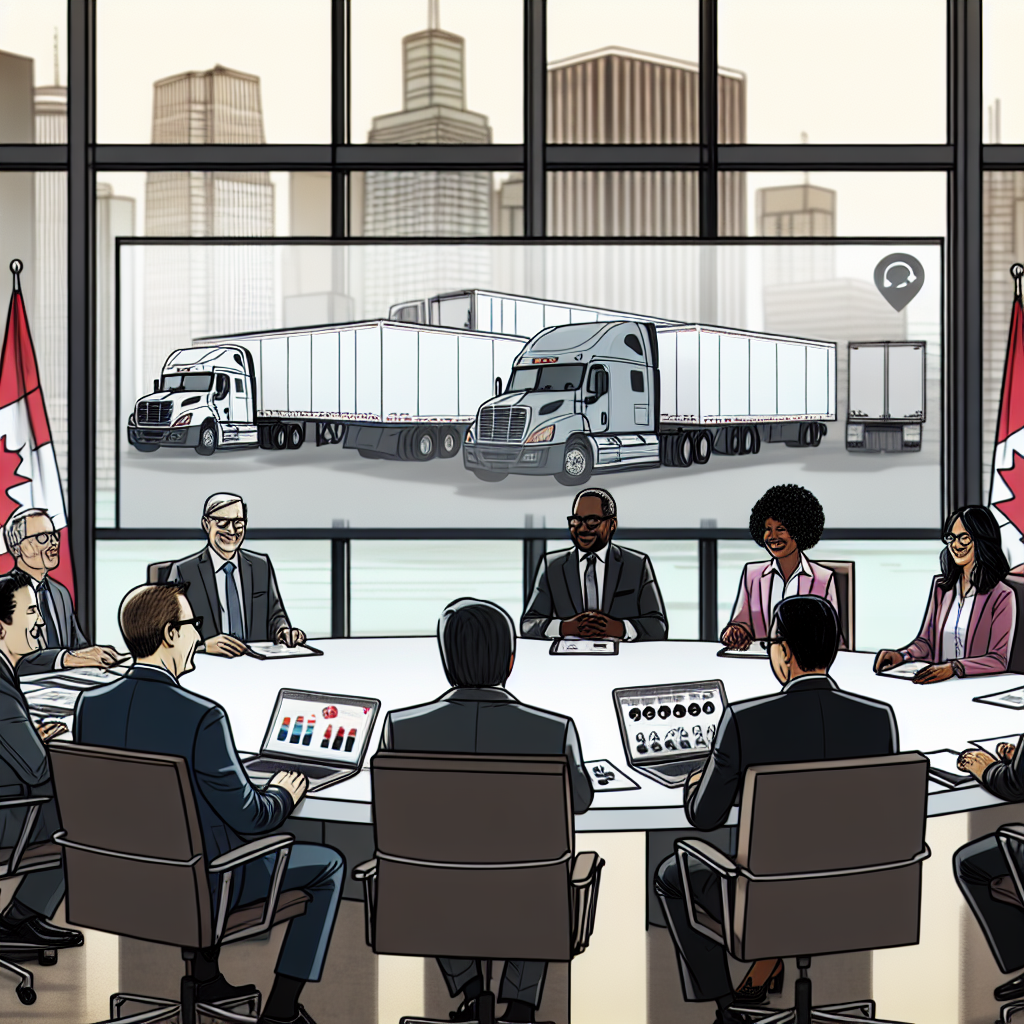In recent years, the trucking industry has faced heightened scrutiny over emissions regulations, prompting an urgent need for strategic clarity. As governmental standards evolve, truck manufacturers are recognizing that the mix of vehicles and their payload capacities play a pivotal role in achieving compliance while simultaneously reducing greenhouse gas emissions.
With the Environmental Protection Agency (EPA) and various states enforcing stricter NOx standards and the upcoming EPA27 technology requirements set to reshape the landscape by 2027, emissions regulation clarity has become more crucial than ever. The divergence in payload allowances and vehicle configurations between Canada and the U.S. has illuminated inherent strategies to lower emissions without heavy technological investments.
As stakeholders navigate these uncharted waters, understanding how vehicle mix and payload impact emissions reduction will not only facilitate compliance but also provoke innovation in sustainable practices within the industry.

Insights on Payload Capacities and Their Impact on Emissions
- The relationship between payload capacities and emissions is crucial for truck manufacturers in light of regulatory targets.
- The EPA has set a NOx reduction target of 0.035 grams by 2027, indicating a rapidly evolving vehicle compliance landscape.
- Heavier payload allowances and varying vehicle mixes between the U.S. and Canada provide methods to reduce GHG emissions without significant technological investments.
- Industry leaders like Sean Waters emphasize that manufacturers have been preparing for the 2027 NOx standards for several years.
- Approximately four million vehicles crossed between Canada and the U.S. last year, highlighting the significance of understanding emissions regulation differences.
- A unified regulatory framework is necessary to facilitate compliance for manufacturers operating in both markets.
- Strategic planning for compliance while effectively managing payloads is essential for meeting the strict emissions standards of 2027 and promoting industry innovation.
The differences in vehicle mixes between Canada and the United States have significant implications for greenhouse gas (GHG) emissions, directly influencing regulatory frameworks. In Canada, approximately half of all light-duty vehicle sales comprise light trucks, whereas in the U.S., this figure stands at around 40%. This disparity indicates that Canada’s vehicle population, which leans more heavily toward light-duty trucks, generally has higher average CO₂ emissions. This aspect underscores the importance of how vehicle configuration affects emissions, as larger vehicles typically contribute more to overall GHG output.
The regulatory landscape also plays a crucial role in shaping these emissions. Historically, Canada has harmonized its vehicle emissions standards with those of the U.S., which is essential for facilitating seamless cross-border trade. The Passenger Automobile and Light Truck Greenhouse Gas Emission Regulations in Canada align with U.S. standards, requiring manufacturers to meet specific fleet average GHG emissions targets. However, recent policy changes, such as the Biden administration’s adjustments to proposed fuel economy regulations, complicate this alignment. These adjustments loosen standards leading up to 2030 and will have trickle-down effects on Canadian regulations due to their interconnectedness.
The diverging regulatory paths underline the urgent need for clarity and consistency in emissions standards. With Canada moving forward with ambitious regulations aimed at achieving 100% zero-emission vehicle (ZEV) sales by 2035, these interim goals necessitate clear guidelines for manufacturers, offering a proactive approach to reducing GHG emissions. Additionally, the Canadian government’s drive to instill regulatory confidence among consumers plays a vital role in this process.
In conclusion, the distinct vehicle mixes in Canada and the U.S. not only impact GHG emissions but also reveal the pressing demand for unified and clear regulatory standards. This clarity is essential for manufacturers striving to navigate the evolving landscape of emissions regulations while addressing environmental concerns effectively. Stakeholders must remain vigilant and engaged in the regulatory processes to foster an industry-wide commitment to emissions reduction, as seamless regulatory frameworks are crucial for achieving emissions targets across both nations.
| Criteria | United States | Canada |
|---|---|---|
| NOx Emission Standard | 0.035 g/bhp-hr (Class 4-5) and 0.050 g/bhp-hr (Class 6-8) | Anticipated alignment with U.S. standards, specifics pending |
| Compliance Timeline | Implemented between 2027-2032 (U.S. EPA) | Expected alignment with U.S. by 2027 |
| Regulatory Body | U.S. Environmental Protection Agency (EPA) | Canadian Environmental Protection Agency (CEPA) |
| Technological Requirements | Advanced emissions control technologies required | Anticipated similar requirements |
| Market Impact | Significant R&D investments for manufacturers necessary | Regulatory consistency crucial for market stability |
| Warranty & Testing Requirements | Extended warranties and rigorous in-use testing | Anticipated similar regulations for warranty and testing |
| Implications for Manufacturers | Potentially increased production costs and market adjustments | Need for unified regulatory approach for efficient compliance |
This table provides a clear comparison of the NOx standards in Canada and the U.S., illustrating the compliance timelines and implications for truck manufacturers. The alignment of these regulations is vital for effective market strategies and environmental goals. This comparative clarity allows manufacturers to navigate the challenges posed by different regulatory landscapes and to prepare adequately for future standards.
Evidence of the Growing Debate Around Emissions Regulation Consistency
The transportation industry is currently engaged in a significant debate regarding the consistency and clarity of emissions regulations, particularly concerning the alignment between U.S. and Canadian standards. Notably, industry leaders have voiced their concerns about potential complications arising from divergent regulations and underscored the essential need for harmonization to facilitate compliance and foster innovation.
Sean Waters, Vice President of Product Compliance and Regulatory Affairs at Daimler Trucks North America (DTNA), articulated a pressing concern regarding the need for consistent regulations across borders. He emphasized, “We have to have the same regulations. Canada is a small market compared to the U.S.” Waters further pointed out that Canada relies heavily on U.S. engine compliance certifications and differing standards could complicate manufacturing processes. He also acknowledged that Canada’s heavier payload allowances can contribute to reducing greenhouse gas emissions, suggesting that regulatory alignment should factor in these aspects.
Echoing Waters’ sentiments, Krista Toenjes, General Manager of North America On-Highway Business at Cummins, remarked, “Right now we’re in a waiting game when it comes to 2027. We have our strategy to hit the 2027 emissions standards… and right now it’s up in the air. I’m not really sure what is going to happen. We just want a decision one way or another. We need clarity on that.” This uncertainty introduces complexities for manufacturers striving to plan and invest in new technologies, as the path to compliance remains unclear.
Rick Mihelic, Director of Emerging Technologies for the North American Council for Freight Efficiency (NACFE), raised further concerns about the operational challenges posed by inconsistent emissions standards between the two nations. With millions of vehicles transitioning between Canada and the United States annually, Mihelic warned that without a consensus, the industry could face hurdles similar to those at the U.S.-Mexico border, where trucks are restricted in their cross-border operations.
Moreover, the call for harmonization transcends North America. Waters has advocated for a global approach to emissions standard alignment, stressing that recognizing standards from regions like the U.S., EU, and Japan as valid would benefit manufacturers and consumers alike by reducing research and development expenditures. He noted that this would allow engineers to concentrate on adding value rather than navigating complex regulations.
In summary, the chorus of voices from industry leaders points to a critical need for consistent and clear emissions regulations to mitigate operational challenges and support the development of effective, compliant technologies. The current uncertainty surrounding the regulatory landscape has amplified the call for coordinated regulatory approaches that enhance compliance, innovation, and environmental stewardship in the transportation sector.
As the regulatory dynamics evolve, multiple studies provide insights into emissions regulations and their implications:
- Canada and the U.S. have harmonized emissions standards, with Canada’s regulations targeting a reduction in greenhouse gas emissions by aligning with U.S. standards for heavy-duty trucks. For more details, refer to TT News.
- The U.S. EPA has introduced new emissions standards aimed at reducing NOx emissions by 80% from heavy-duty vehicles starting in 2027 in recognition of real-world emissions discrepancies. More information can be found at Truck News.
- Canadian emissions regulations align with the U.S. EPA to ensure consistent standards across North America. Additional information is available on Wikipedia.
- Recent findings by the International Council on Clean Transportation highlighted significant real-world NOx emissions exceeding standards for diesel pickup trucks in the U.S., prompting stricter regulatory action. Explore this study at ICCT.
This reliance on harmonized standards underscores the industry’s push toward coherent regulatory strategies to minimize operational hurdles while enhancing compliance and technological innovation.
Conclusion
As the trucking industry grapples with stringent emissions regulations, the clarity of these regulations and the strategic mix of vehicle types emerge as pivotal factors in reducing greenhouse gas emissions. Clearer regulations not only foster compliance among manufacturers but also stimulate innovation in vehicle design and technology, ensuring that companies can meet the upcoming challenges posed by the evolving regulatory landscape.
The incorporation of varied vehicle types into fleets allows for more flexible payload capacities, thereby optimizing operations and enhancing overall efficiency. This vehicle mix strategy is particularly evident in the contrasting regulatory environments of Canada and the U.S., where harmonizing standards could significantly improve operational coherence and reduce administrative burdens for manufacturers. By aligning standards, companies can navigate the compliance landscape more effectively, saving costs and reducing their ecological footprint.
Looking ahead, the industry stands at a crossroads where proactive adaptation to clear regulations and a diverse vehicle mix will not only be essential for compliance but also pivotal in steering the shift towards more sustainable practices. The determination to embrace innovation, focus on collaborative regulatory strategies, and invest in cleaner technologies will define the future of the trucking sector.
In conclusion, the path toward achieving meaningful reductions in emissions lies in embracing clarity in regulations and leveraging the potential of a well-mixed vehicle fleet. As stakeholders engage in this vital endeavor, the positive impacts will resonate across the industry and contribute toward a greener, more sustainable transport future.


An illustration depicting a meeting between Canadian and U.S. regulators discussing emissions standards for trucks, symbolizing regulatory clarity and collaboration.
Quotes on Regulatory Clarity in the Trucking Industry
The following quotes from notable figures in the trucking industry highlight the prevalent concerns regarding the need for regulatory clarity, especially related to emissions standards:
-
Sean Waters, Vice President of Compliance and Regulatory Affairs at Daimler Truck North America, stated:
“We have to have the same regulations. Canada is a small market compared to the U.S.”
-
Krista Toenjes, General Manager of North America On-Highway Business at Cummins, remarked on the current uncertainties:
“Right now we’re in a waiting game when it comes to 2027. We have our strategy to hit the 2027 emissions standards, which is 0.035 NOx, and right now it’s up in the air. I’m not really sure what is going to happen. We just want a decision one way or another. We need clarity on that.”
-
Chris Spear, President and CEO of the American Trucking Associations (ATA), voiced his concerns post-EPA’s Phase 3 emissions rule:
“The post-2030 targets are entirely unachievable given the current state of zero-emission technology, the lack of charging infrastructure, and restrictions on the power grid.”
-
Jim Ward, President of the Truckload Carriers Association (TCA), warned that new emissions standards could limit equipment options for carriers:
“The new emissions standards for heavy-duty trucks would limit equipment options and could worsen environmental outcomes by raising prices.”
These insights reflect a shared concern among industry leaders regarding the implications of current regulations for compliance and technological adaptation, emphasizing the crucial need for clear and consistent emissions standards across borders.
FAQ on Payload and Emissions Regulation
What is the impact of payload capacity on emissions?
Payload capacity affects truck emissions directly. While heavier payloads can increase emissions, they might also allow for fewer trips overall, reducing emissions. This creates a balance where optimizing payload capacity can help lower emissions when done correctly.
How do emissions regulations differ between Canada and the U.S.?
Emissions regulations for trucks in Canada and the U.S. show notable differences, especially in payload capacities and vehicle mixes. Canada has distinct standards that can either ease or complicate compliance for manufacturers operating in both markets. Understanding these regulations is key for effective compliance and operational strategies.
What are the compliance requirements for truck manufacturers?
Truck manufacturers must follow strict emissions standards set by regulations, including upcoming NOx reduction targets. These standards specify emission limits and compliance deadlines, which require manufacturers to invest in cleaner technologies and adapt vehicle designs accordingly.
How will future emissions regulations shape the trucking industry?
Future emissions regulations will likely push the trucking industry toward more innovative and sustainable practices. As rules become stricter, manufacturers will need to adapt by utilizing advanced technologies for emissions control and optimizing vehicle mixes and payload capacities to stay compliant and competitive.
What is the outlook for zero-emission vehicles in the trucking industry?
The outlook for zero-emission vehicles (ZEVs) in the trucking sector is promising, with rising regulatory pressure to phase out traditional fossil fuel-powered trucks. Strategies will foster ZEV adoption by 2035 in Canada and similar initiatives in the U.S., shaping the industry’s future and necessitating changes in infrastructure, technology, and fleet management strategies.
The Role of Payload and Vehicle Mix in Reducing GHG Emissions in Trucks
Introduction
In recent years, the trucking industry has faced heightened scrutiny over emissions regulations, prompting an urgent need for strategic clarity. As governmental standards evolve, truck manufacturers are recognizing that the mix of vehicles and their payload capacities play a pivotal role in achieving compliance while simultaneously reducing greenhouse gas emissions. With the Environmental Protection Agency (EPA) and various states enforcing stricter NOx standards and the upcoming EPA27 technology requirements set to reshape the landscape by 2027, emissions regulation clarity has become more crucial than ever. The divergence in payload allowances and vehicle configurations between Canada and the U.S. has illuminated inherent strategies to lower emissions without heavy technological investments. As stakeholders navigate these uncharted waters, understanding how vehicle mix and payload impact emissions reduction will not only facilitate compliance but also provoke innovation in sustainable practices within the industry.
Image

Insights on Payload Capacities and Their Impact on Emissions
The relationship between payload capacities and emissions has emerged as a crucial consideration for truck manufacturers, especially in light of stringent regulatory targets. With the Environmental Protection Agency (EPA) setting a NOx reduction target of 0.035 grams by 2027, the landscape of vehicle compliance is rapidly evolving. This ambitious goal will significantly challenge industry players, making it imperative to adopt innovative strategies to meet these regulations.
A pivotal insight is that heavier payload allowances and varying vehicle mixes, especially between the U.S. and Canada, can serve as inherent methods to reduce greenhouse gas emissions without heavily relying on drastic technological changes. According to Sean Waters, an industry expert, “the most important thing the OEMs have been doing over the last five to seven years is getting ready for the 2027 NOx standards.” This statement underscores the proactive measures manufacturers like Daimler Truck North America and Cummins have been taking to align with compliance strategies that encompass not only emission standards but also effective payload management.
Furthermore, with approximately four million vehicles crossing the border from Canada to the U.S. last year, understanding and addressing the differences in emissions regulations between the two nations has become paramount. James Menzies notes, “We have to have the same regulations. Canada is a small market compared to the U.S.” This highlights the necessity for a unified regulatory framework to facilitate compliance among manufacturers operating in both markets.
To sum up, insights regarding payload capacities and their implications for emissions regulations stress the importance of strategic compliance planning as truck manufacturers gear up for the upcoming challenges. The ability to effectively manage payloads while adhering to the stringent emissions standards set forth for 2027 will not only be essential for regulatory compliance but could also drive innovation in the industry. As the debate continues, stakeholders will need to remain focused on coherent strategies that bridge technological advancements with effective vehicle management practices.

Illustration showing the impact of payload capacities on emissions reduction in trucks.
Vehicle Mix and GHG Emissions
The differences in vehicle mixes between Canada and the United States have significant implications for greenhouse gas (GHG) emissions, directly influencing regulatory frameworks. In Canada, approximately half of all light-duty vehicle sales comprise light trucks, whereas in the U.S., this figure stands at around 40%. This disparity indicates that Canada’s vehicle population, which leans more heavily toward light-duty trucks, generally has higher average CO₂ emissions. This aspect underscores the importance of how vehicle configuration affects emissions, as larger vehicles typically contribute more to overall GHG output.
The regulatory landscape also plays a crucial role in shaping these emissions. Historically, Canada has harmonized its vehicle emissions standards with those of the U.S., which is essential for facilitating seamless cross-border trade. The Passenger Automobile and Light Truck Greenhouse Gas Emission Regulations in Canada align with U.S. standards, requiring manufacturers to meet specific fleet average GHG emissions targets. However, recent policy changes, such as the Biden administration’s adjustments to proposed fuel economy regulations, complicate this alignment. These adjustments loosen standards leading up to 2030 and will have trickle-down effects on Canadian regulations due to their interconnectedness.
The diverging regulatory paths underline the urgent need for clarity and consistency in emissions standards. With Canada moving forward with ambitious regulations aimed at achieving 100% zero-emission vehicle (ZEV) sales by 2035, these interim goals necessitate clear guidelines for manufacturers, offering a proactive approach to reducing GHG emissions. Additionally, the Canadian government’s drive to instill regulatory confidence among consumers plays a vital role in this process.
In conclusion, the distinct vehicle mixes in Canada and the U.S. not only impact GHG emissions but also reveal the pressing demand for unified and clear regulatory standards. This clarity is essential for manufacturers striving to navigate the evolving landscape of emissions regulations while addressing environmental concerns effectively. Stakeholders must remain vigilant and engaged in the regulatory processes to foster an industry-wide commitment to emissions reduction, as seamless regulatory frameworks are crucial for achieving emissions targets across both nations.
Comparison of NOx Standards in Canada and the U.S.
| Criteria | United States | Canada |
|---|---|---|
| NOx Emission Standard | 0.035 g/bhp-hr (Class 4-5) and 0.050 g/bhp-hr (Class 6-8) | Anticipated alignment with U.S. standards, specifics pending |
| Compliance Timeline | Implemented between 2027-2032 (U.S. EPA) | Expected alignment with U.S. by 2027 |
| Regulatory Body | U.S. Environmental Protection Agency (EPA) | Canadian Environmental Protection Agency (CEPA) |
| Technological Requirements | Advanced emissions control technologies required | Anticipated similar requirements |
| Market Impact | Significant R&D investments for manufacturers necessary | Regulatory consistency crucial for market stability |
| Warranty & Testing Requirements | Extended warranties and rigorous in-use testing | Anticipated similar regulations for warranty and testing |
| Implications for Manufacturers | Potentially increased production costs and market adjustments | Need for unified regulatory approach for efficient compliance |
This table provides a clear comparison of the NOx standards in Canada and the U.S., illustrating the compliance timelines and implications for truck manufacturers. The alignment of these regulations is vital for effective market strategies and environmental goals. This comparative clarity allows manufacturers to navigate the challenges posed by different regulatory landscapes and to prepare adequately for future standards.
Evidence of the Growing Debate Around Emissions Regulation Consistency
The transportation industry is currently engaged in a significant debate regarding the consistency and clarity of emissions regulations, particularly concerning the alignment between U.S. and Canadian standards. Notably, industry leaders have voiced their concerns about potential complications arising from divergent regulations and underscored the essential need for harmonization to facilitate compliance and foster innovation.
Sean Waters, Vice President of Product Compliance and Regulatory Affairs at Daimler Trucks North America (DTNA), articulated a pressing concern regarding the need for consistent regulations across borders. He emphasized, “We have to have the same regulations. Canada is a small market compared to the U.S.” Waters further pointed out that Canada relies heavily on U.S. engine compliance certifications and differing standards could complicate manufacturing processes. He also acknowledged that Canada’s heavier payload allowances can contribute to reducing greenhouse gas emissions, suggesting that regulatory alignment should factor in these aspects.
Echoing Waters’ sentiments, Krista Toenjes, General Manager of North America On-Highway Business at Cummins, remarked, “Right now we’re in a waiting game when it comes to 2027. We have our strategy to hit the 2027 emissions standards… and right now it’s up in the air. I’m not really sure what is going to happen. We just want a decision one way or another. We need clarity on that.” This uncertainty introduces complexities for manufacturers striving to plan and invest in new technologies, as the path to compliance remains unclear.
Rick Mihelic, Director of Emerging Technologies for the North American Council for Freight Efficiency (NACFE), raised further concerns about the operational challenges posed by inconsistent emissions standards between the two nations. With millions of vehicles transitioning between Canada and the United States annually, Mihelic warned that without a consensus, the industry could face hurdles similar to those at the U.S.-Mexico border, where trucks are restricted in their cross-border operations.
Moreover, the call for harmonization transcends North America. Waters has advocated for a global approach to emissions standard alignment, stressing that recognizing standards from regions like the U.S., EU, and Japan as valid would benefit manufacturers and consumers alike by reducing research and development expenditures. He noted that this would allow engineers to concentrate on adding value rather than navigating complex regulations.
In summary, the chorus of voices from industry leaders points to a critical need for consistent and clear emissions regulations to mitigate operational challenges and support the development of effective, compliant technologies. The current uncertainty surrounding the regulatory landscape has amplified the call for coordinated regulatory approaches that enhance compliance, innovation, and environmental stewardship in the transportation sector.
Conclusion
As the trucking industry grapples with stringent emissions regulations, the clarity of these regulations and the strategic mix of vehicle types emerge as pivotal factors in reducing greenhouse gas emissions. Clearer regulations not only foster compliance among manufacturers but also stimulate innovation in vehicle design and technology, ensuring that companies can meet the upcoming challenges posed by the evolving regulatory landscape.
The incorporation of varied vehicle types into fleets allows for more flexible payload capacities, thereby optimizing operations and enhancing overall efficiency. This vehicle mix strategy is particularly evident in the contrasting regulatory environments of Canada and the U.S., where harmonizing standards could significantly improve operational coherence and reduce administrative burdens for manufacturers. By aligning standards, companies can navigate the compliance landscape more effectively, saving costs and reducing their ecological footprint.
Looking ahead, the industry stands at a crossroads where proactive adaptation to clear regulations and a diverse vehicle mix will not only be essential for compliance but also pivotal in steering the shift toward more sustainable practices. The determination to embrace innovation, focus on collaborative regulatory strategies, and invest in cleaner technologies will define the future of the trucking sector.
In conclusion, the path toward achieving meaningful reductions in emissions lies in embracing clarity in regulations and leveraging the potential of a well-mixed vehicle fleet. As stakeholders engage in this vital endeavor, the positive impacts will resonate across the industry and contribute toward a greener, more sustainable transport future.
Image


An illustration depicting a meeting between Canadian and U.S. regulators discussing emissions standards for trucks, symbolizing regulatory clarity and collaboration.
Quotes on Regulatory Clarity in the Trucking Industry
-
Sean Waters, Vice President of Compliance and Regulatory Affairs at Daimler Truck North America, stated:
“We have to have the same regulations. Canada is a small market compared to the U.S.”
-
Krista Toenjes, General Manager of North America On-Highway Business at Cummins, remarked on the current uncertainties:
“Right now we’re in a waiting game when it comes to 2027. We have our strategy to hit the 2027 emissions standards, which is 0.035 NOx, and right now it’s up in the air. I’m not really sure what is going to happen. We just want a decision one way or another. We need clarity on that.”
-
Chris Spear, President and CEO of the American Trucking Associations (ATA), voiced his concerns post-EPA’s Phase 3 emissions rule:
“The post-2030 targets are entirely unachievable given the current state of zero-emission technology, the lack of charging infrastructure, and restrictions on the power grid.”
-
Jim Ward, President of the Truckload Carriers Association (TCA), warned that new emissions standards could limit equipment options for carriers:
“The new emissions standards for heavy-duty trucks would limit equipment options and could worsen environmental outcomes by raising prices.”
These insights reflect a shared concern among industry leaders regarding the implications of current regulations for compliance and technological adaptation, emphasizing the crucial need for clear and consistent emissions standards across borders.
FAQ on Payload and Emissions Regulation
What is the impact of payload capacity on emissions?
Payload capacity affects truck emissions directly. While heavier payloads can increase emissions, they might also allow for fewer trips overall, reducing emissions. This creates a balance where optimizing payload capacity can help lower emissions when done correctly.
How do emissions regulations differ between Canada and the U.S.?
Emissions regulations for trucks in Canada and the U.S. show notable differences, especially in payload capacities and vehicle mixes. Canada has distinct standards that can either ease or complicate compliance for manufacturers operating in both markets. Understanding these regulations is key for effective compliance and operational strategies.
What are the compliance requirements for truck manufacturers?
Truck manufacturers must follow strict emissions standards set by regulations, including upcoming NOx reduction targets. These standards specify emission limits and compliance deadlines, which require manufacturers to invest in cleaner technologies and adapt vehicle designs accordingly.
How will future emissions regulations shape the trucking industry?
Future emissions regulations will likely push the trucking industry toward more innovative and sustainable practices. As rules become stricter, manufacturers will need to adapt by utilizing advanced technologies for emissions control and optimizing vehicle mixes and payload capacities to stay compliant and competitive.
What is the outlook for zero-emission vehicles in the trucking industry?
The outlook for zero-emission vehicles (ZEVs) in the trucking sector is promising, with rising regulatory pressure to phase out traditional fossil fuel-powered trucks. Strategies will foster ZEV adoption by 2035 in Canada and similar initiatives in the U.S., shaping the industry’s future and necessitating changes in infrastructure, technology, and fleet management strategies.


